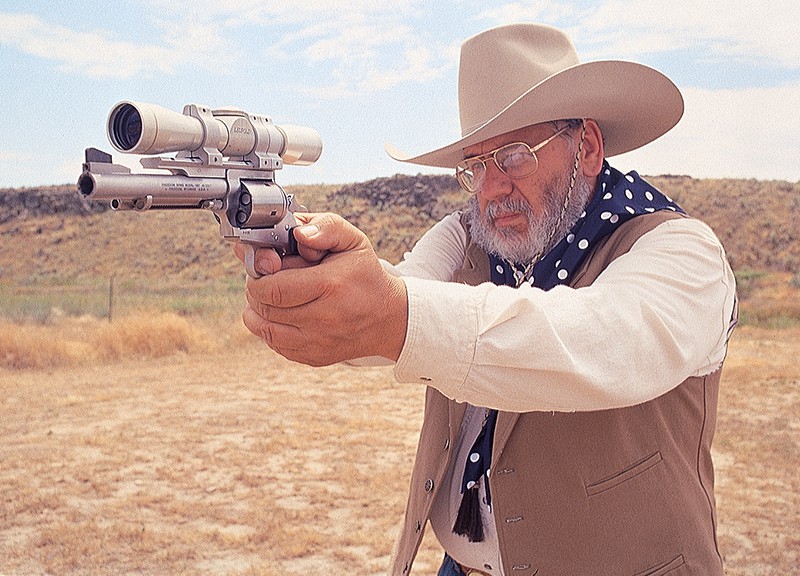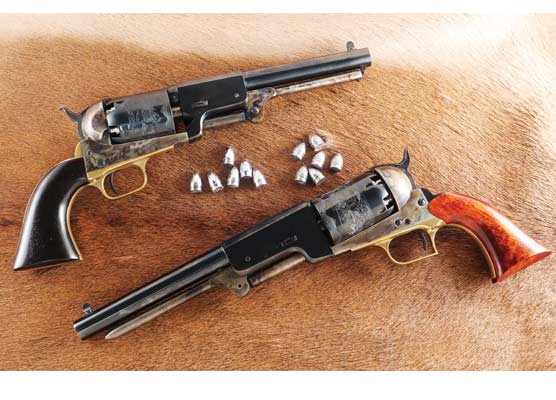You readers must have guessed I hit steel most often with my 7½" .38-40. In truth I did, but actually shot well with all my .38-40 SAAs of which there are six others. Colt reintroduced .38-40 SAAs in 1993 and made them well into the 21st century. By my standards, all have been good revolvers with consistent barrel groove diameters of 0.400" and cylinder chamber mouths of 0.401". They have been some of the most accurate single action revolvers of my considerable experience.
Interestingly, until very late in the 1st Generation Colt caliber stamped their SAAs .38 WCF. Towards the end the marking was changed to .38-40. When reintroduced in 1993 the latter marking remained. However very late in the 20th century some SAAs ordered from the custom shop again carried the .38 WCF marking. I have them both ways. Also I have them with blue and color case hardened finish and fully nickel-plated.
The .38 WCF Duke’s
“today’s favorite”
People sometimes ask, “What’s your favorite gun?” Or sometimes it’s, “What’s your favorite cartridge?” I always reply, “You mean today? I change my mind about it often.” Today, as I write this column my favorite cartridge is .38-40, actually introduced as .38 Winchester Centerfire (.38 WCF). The proper date was 1879, not 1874 as sometimes written. The introductory firearm was Winchester’s Model 1873 lever gun. Other rifle manufacturers followed, such as Marlin with their Model 1894 lever gun, Colt with their Lightning pump action and even Remington with a more modern pump-action named Model 14½ .
Sixguns
Smith & Wesson made a few top break Model Three .38-40 revolvers and even some later swing-cylinder N-Frame Hand Ejectors. Both types of S&Ws are so rare as to be nigh on invisible. Colt added .38-40 as a chambering in their Single Action Army revolver in 1884. Contrary to S&W’s luck with the cartridge, it became the SAA’s third most popular in regards to numbers prior to the end of 1st Generation production in 1941. Today my favorite revolver is an SAA made in 1926 and sent to a hardware store in Salt Lake City, according to its factory letter of authenticity. The letter also relates it left the factory with a 7½” barrel, blued and color case hardened finish with the type of grips unknown. It still wears the same barrel, has some blue and frame colors remaining and its grips are modern hard rubber replacements for its originals, whatever they were.
Counting the reasons
Why is SAA .38-40 so well esteemed by me currently? During this first half of 2020 not only have we been locked down here on “Rancho Venturino” due to the pandemic but I’ve suffered from some severe lower back troubles. The only shooting I’ve been able to do has been by sitting on a chair and firing out the window of my shooting shack. For recreation, I’ve been taking three Colt SAAs at a time and spending a few hours plinking at some steel plates at 25 yards. To make it interesting, I’ve fired a mix of chamberings — .38 Special, .38-40, .44 Special, .44-40 and .45 Colt — also with a variety of barrel lengths from 4 to 7½”.
The Answer Man
As much as I like SAA .38-40s (also .38-40 lever guns, but it’s for another column), there are two questions that deserve asking. One is: Why did Winchester introduce it in the first place? In actuality its case is merely the .44 WCF/.44-40 (introduced 1873) with its neck squeezed down from taking 0.425″ bullets to taking 0.400″ ones. (Diameters of factory-loaded lead bullets in the 1870s.) Original factory bullet weight for .44 was 200 grains and bullet weight for .38 was 180 grains.
My second question is: Why was this cartridge named .38? As said above, its bullets are true .40 calibers and Winchester’s black powder factory loads only carried 38 grains of powder instead of 40. Logically, it should have been named .40-38 WCF. Of course people in charge of naming metallic cartridges from the very beginning have seemed a half-bubble off normal.
Of the big three ammunition manufacturers today — Winchester, Remington and Federal — only the first makes .38-40 factory loads with 180-gr. jacketed soft-point bullets. Black Hills may be a smaller ammo manufacturer but their .38-40 factory loads with 180-gr. lead RN/FPs are exceptional. Now in my golden years I favor only one .38-40 handload — 175- to 180-gr. RN/FP cast lead bullets over 5.5 grains of Hornady’s Trail Boss powder. At 750 to 850 fps depending on barrel length it’s not very powerful but suits my needs completely.










